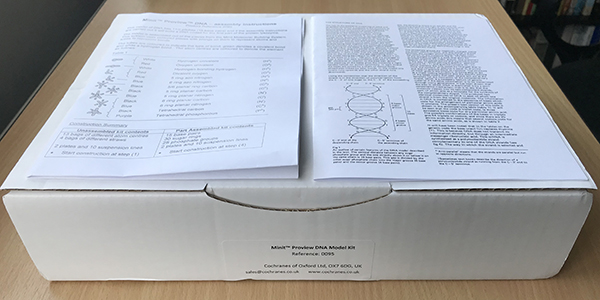
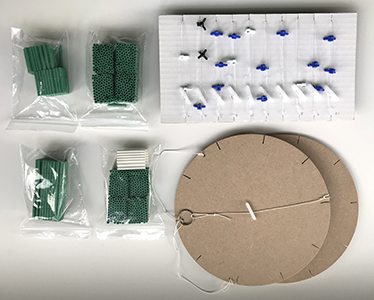
|
Micscape Lite - Product Review Cochranes of Oxford Minit Proview DNA model kit. by David Walker, UK |
One lockdown project during the Covid-19 pandemic that had set myself was to build a challenging physical model kit of DNA.
In a few minutes nowadays it is possible to install free molecular modelling apps for both smartphones and computers that allow complex molecules in a standard format from databases to be downloaded and displayed. They can then be explored on screen but with an existing interest in physical models I was keen to build an example; an alternative to the 1000 piece jigsaw or bumper book of Sudoku puzzles to wile away the hours and learn at the same time!
There are a very wide range of models available from the simple showing basic base-pairing structure with the double helix to more advanced examples that are built at the atomic level. The latter were the more appealing and in the UK two main models stood out. Cochranes of Oxford (UK) offer a kit using both their Minit and Orbit systems. I was very familiar with both of these systems and have shared reviews in a previous Micscape Lite article of five molecular model systems (Minit, Orbit, ChemKits, Molymod and Darling Models (Molecular Visions)). The Minit suggested bond length scale is 2 cm = 1 Å, the Orbit 3 cm. In a domestic setting the size of the final Minit DNA model was the more suited in size so opted for this one. An assembled large Orbit model is shown on Cochranes website next to a builder.
The self-assembly Minit kit is £123 exc. VAT and the better value found of the more complex systems. The plastic atoms and bonds in themselves are likely of modest value but suspect much of the price reflects the time taken to assemble the components to ease the build. In particular the ten string suspension lines with part assembled atoms in place at each base-pair location. This looks fiddly to assemble if assigned to the first time builder like myself but greatly eases the build (see below). The part assembled Minit system is £397 exc. VAT, reflecting the time taken to build such a kit. (The comparable Orbit kits are £130 and £330.) The captions on the images below describe aspects of the kit and building. Some suggested tips that I found useful during the build are offered.


The kit is simply presented in a card box. The lefthand sheet folds out providing step by step instructions on building the components and assembling them onto the string supports. The righthand provides valuable and clear background information on the structure of DNA. For simplicity the pre-cut bond lengths used are those to nearest 0.5 cm and are 1.5, 2.0, 2.5 and 3.5. The bond plastic is a quite hard non-flexible type (the larger Orbit bonds are somewhat more flexible and rubbery).
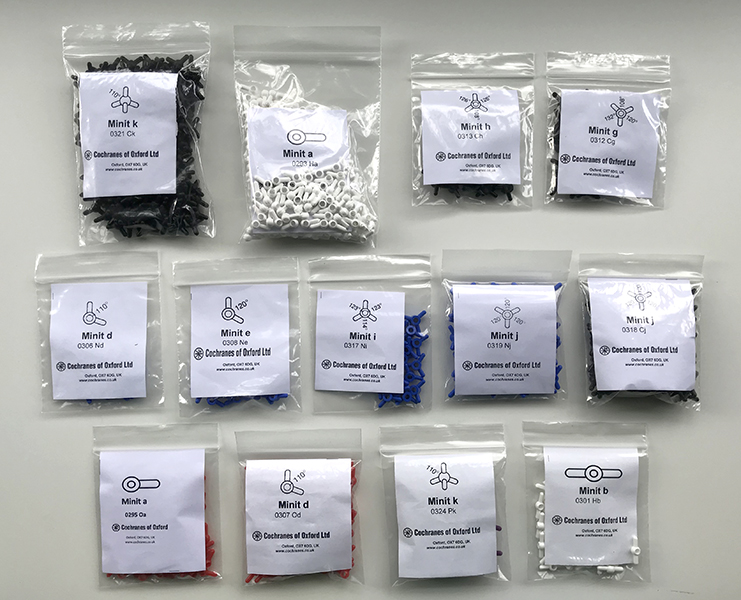
Atom centres are separately bagged each with their code used during assembly. Both the Minit kit here and the Orbit are two of the few molecular model systems that have come across that are rigorous in supplying the atom centres where they have varying bond angles. This is important for accuracy in builds such as DNA because of the strained atom centres in five membered rings of the bases. Some other systems avoid this by using flexible bonds to account for the strain but this potentially loses part of the learning process in the build of how bond angles vary.
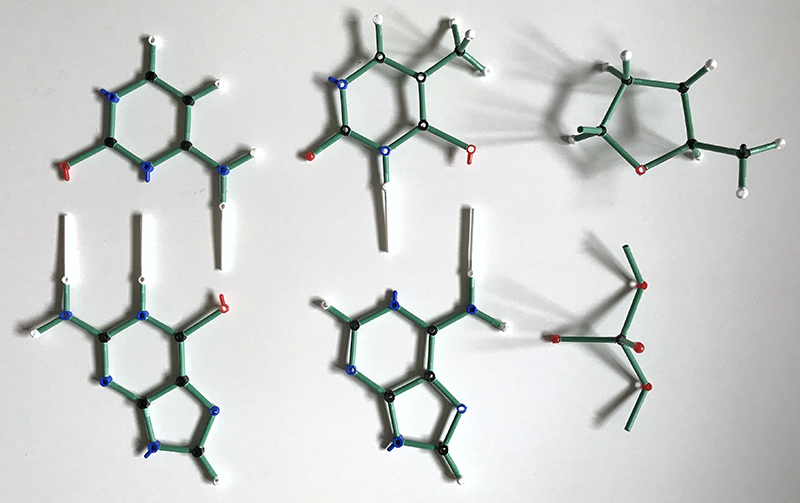
The four base pairs, phosphate group, deoxyribose sugar group. Tip: The instructions suggest the base pairs are built first but these require the most care. I preferred to build in order of complexity, i.e. phosphates, sugars, thymine / cytosine base pairs (pyrimidines, single ring), adenine / guanine (purine double ring). (The phosphate orientation shown is not that adopted in the model). The long white bonds are hydrogen bonds between C-G and T-A.
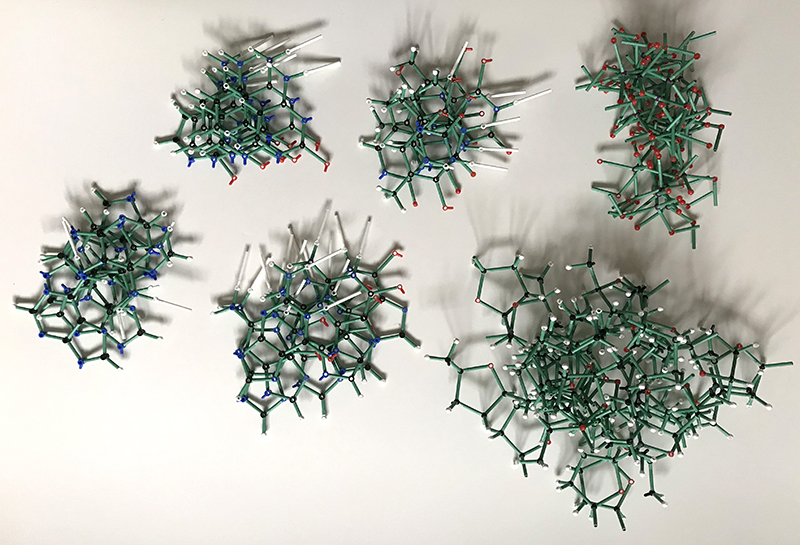
The six sub-groups shown here assembled. The builder really becomes familiar with their structure at the atomic level when building the required 28 phosphates, 30 sugar rings and 15 base pairs! The kit notes does not mention the extra two phosphates and two open oxygen bonds to terminate the 3' and 5' ends for both backbones but there are spare atoms to add these.
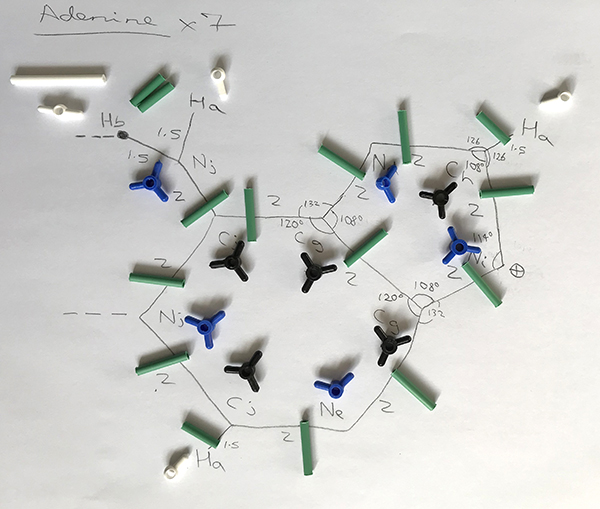
Tip: As the bases use a variety of atom centres depending on for example ring strain, it is useful to prepare a template for each base and lay on the correct atoms and bond lengths prior to assembly. For example the two planar nitrogens and carbons in the five membered ring are strained and use Ni, Ch and Cg whereas the six membered rings use Nj and Cj. The Minit system marks angles with tick marks, the Orbit imprints the angles. (The positive symbol is used to denote an atom attached to the strings, not a charge).
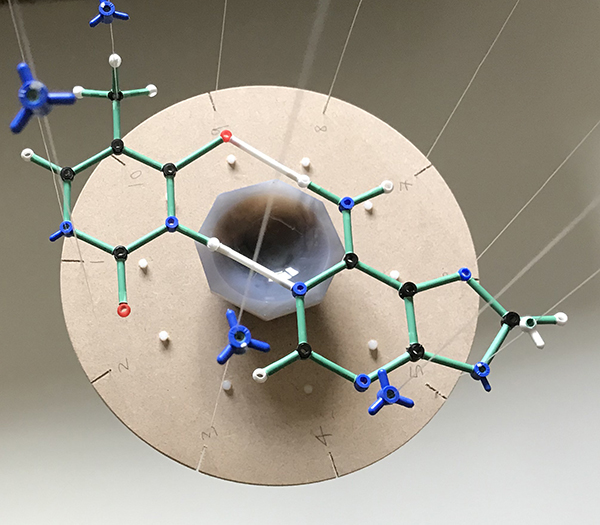
The nylon strings are assembled between the top and bottom plate, the latter weighted until the build complete. The pre-assembled T-A and G-C base pairs are then added to the captive atom centres on the strings by removing that atom from the built groups. This introduces the correct helical twist before the outer sugar-phosphate background are added. Tip: before adding the base pairs it is useful to mark with white paint (e.g.
Tippex correction fluid) the 114° bond angle in the Ni centre where it features on the strings (blue atom centre bottom left in above image). This should face into the ring on attaching base pairs. This angle, marked as a tick mark, is not easy to see when on the strings.
When all 15 base pairs have been added, the sugar rings are added to the captive nitrogens. The planes of the sugar rings are at right angles to that of the bases. The phosphate groups have their bonds preset as described in the notes allowing final assembly of the sugar - phosphate backbones. Tip: A limitation of the small Minit atom centres and stiff plastic bonds is that their rotational stiffness can vary, especially if bonds are reused. The sugar rings can sag away from vertical in the backbone after final assembly. To prevent this, any that are too loose can have a touch of Superglue added to the nitrogen bond prong where the sugar attaches.
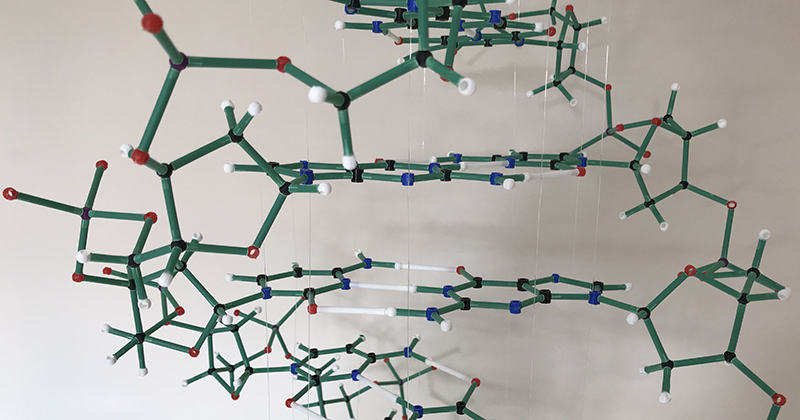
Detail of base pair planes, the sugar rings at right angles to these planes and the connecting phosphate groups. On the left hand strand the oxygens (red) in the five membered sugar rings all point down whereas on the right they point up.
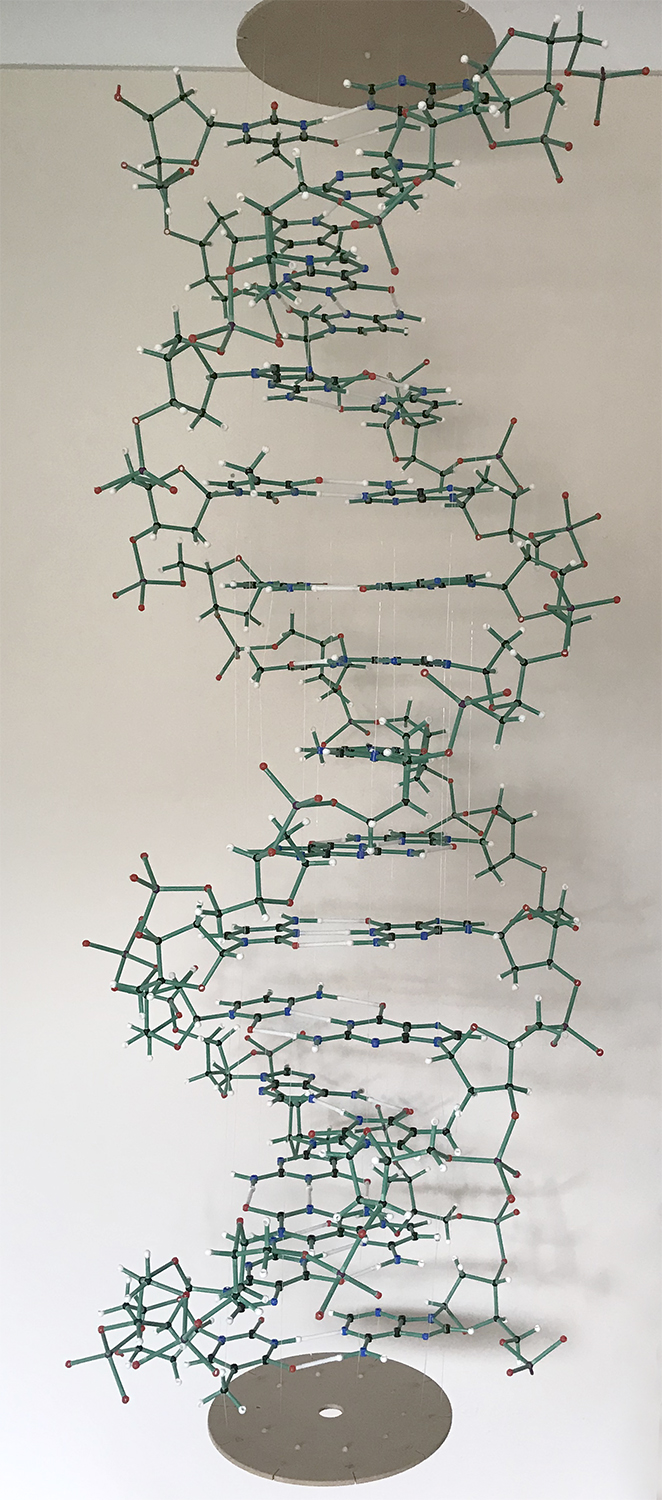
The completed model, size ca. 127 x 41 cm including hanger. Suspended from a ceiling hook it does not occupy too much space and now a permanent feature in a corner of my hobby room. It is interesting than in the flattening of this photo and losing the third dimension, I again find it tricky appreciating the helical nature; it looks especially muddled at the intersects. In real life it is much clearer; the benefit of a model!
General comments on the kit. I have greatly enjoyed assembling this model and very satisfying when complete. It is not difficult, but just requires time aided by the excellent step by step instructions. By picking up the build an hour or two each day it was finished within a week but was not hurrying. In an educational setting for which they are intended, students could split the project between them and make rapid progress.
I've certainly learnt a lot more about DNA structure than just by viewing images in a book, especially the backbone structure which have found not easy to fully appreciate in photos. Many of the major aspects of DNA structure can be understood; the base pairing, the major and minor grooves in the base pairs, the two helices and right handed nature, the arrangement of the sugar phosphate backbone.
The best way have read to appreciate the handedness of a helix is to imagine walking down one of the strands as a spiral staircase. If keeping turning right it is right handed and vice versa. Nature invariably adopts right handed helices with some exceptions.
If there are constraints such as budget, time and even space it is possible to understand many aspects with models with a couple of base pairs coupled with some simpler models to show the helical structure. In part two in the June 2021 issue, examples of these models will be shown using the Orbit, Molymod, ChemKits, Darling Models (Molecular Visions), DynamicDNA to assess their pros and cons. Complemented with very simple and cheap model kits that are available to show the extended helical structure and base pairing.
Comments to the author David Walker are welcomed.
Footnote: If acquiring this kit and the instructions are labelled 2017v1 there is an error that states the numbered strings should be installed on the plates anticlockwise. This gives an incorrect left handed helix; I only realised after completion. Cochranes confirmed the error and will amend further instructions. Although I likely learnt more about the handedness of helices by building both! Only the final assembly was affected. Thank you to Tom Cochrane for his help who also supplied for free some new bonds for those that need to be replaced so as to retain their new rotational stiffness.
A US supplier of kits made by UK manufacturers Molymod and Cochranes of Oxford (Minit and Orbit) are Indigo Instruments. They also sell a range of assembled DNA models on stands using these systems including models with 12 and 36 base pair helices.
Published in the April 2021 edition of Micscape. M inor revision June 19th 2021.
Please report any Web problems or offer general comments to the Micscape Editor .
Micscape is the on-line monthly magazine of the Microscopy UK web site at Microscopy-UK
© Onview.net
Ltd, Microscopy-UK, and all contributors 1995 onwards. All rights
reserved.
Main site is at www.microscopy-uk.org.uk
with full mirror at
www.microscopy-uk.net
.